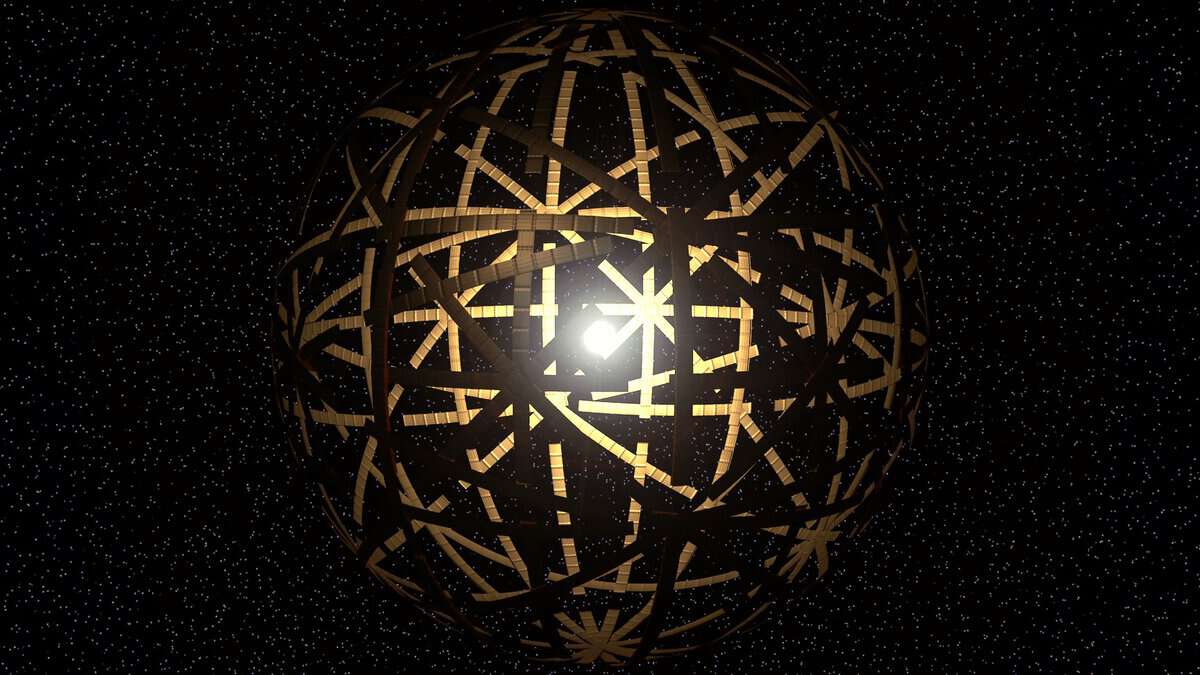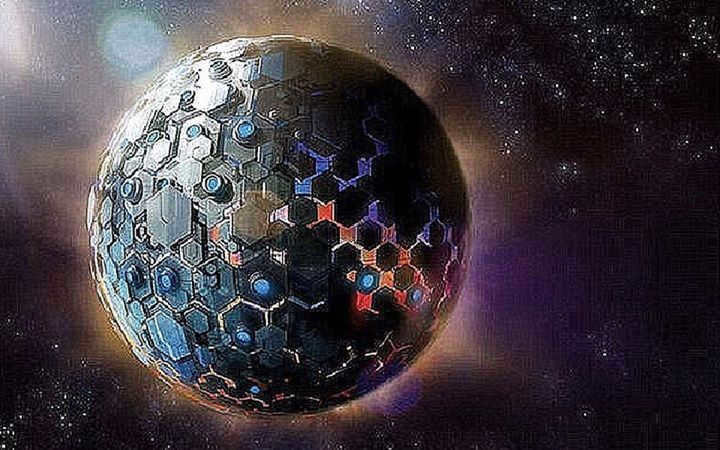
In the realm of ideas that emerged in the 20th century, there are three notable concepts: the Fermi paradox, the Kardashian scale, and the Dyson sphere. While I won’t delve into their intricacies, which can be explored through the provided links, I will highlight that they all revolve around the assumption of highly advanced intelligent civilizations existing in the vast expanse of the Universe. Despite the absence of any concrete evidence of extraterrestrial intelligence thus far, these ideas shed light on the potential behavior of the supercivilizations we aspire to one day encounter. These behaviors can be summarized as follows:
- Given the existence of numerous civilizations that are as advanced as our own, it is perplexing that the universe remains silent, which is why Fermi found it paradoxical. This curiosity and eagerness to communicate with other intelligent beings is a characteristic trait of humanity.
- As civilizations progress, there is a constant need for technological advancement, which in turn requires an increase in energy consumption. This transition from primitive energy sources to more advanced and abundant ones is an integral part of the development of any civilization.
- In order to climb up the Kardashian scale and advance further, it is crucial to optimize the utilization of the energy emitted by our Sun. Currently, a significant portion of this energy dissipates into space. To maximize its potential, it would be logical to construct a man-made sphere around the Sun, which could serve as a massive solar array or even as a settlement for human beings.
- In this article, I will discuss the current ideas regarding the Dyson sphere (although it’s important to note that it may not actually be a spherical shape), while also providing a brief overview of its history.
- The concept of the Dyson Sphere and its various derivatives in astroengineering offer potential solutions not only to the energy and population challenges faced by our growing civilization, but also to the exploration of uninhabited star systems devoid of habitable planets.
- For the purpose of staying focused on the main topic, I will not delve into the concept of the “brain-matryoshka” here, as it is more informational than energetic and deserves a separate discussion. Additionally, I won’t provide an extensive review of astroengineering structures, but I recommend reading the hubrastatya from the blog of the company “Asus” for more information.
However, let’s discuss everything in a systematic manner.

The idea
In 1960, Freeman Dyson put forward a notion in an article proposing that a highly advanced civilization, already engaged in extensive exploration of its own star system, could construct a complete sphere at a distance of approximately 2 astronomical units from the star (which is “orbiting the sun at twice the distance of Earth from it”). This sphere would be specifically designed to harvest the star’s radiation and generate energy. Dyson’s calculations indicated that the sphere would completely obscure the star from external observers, and the outer surface of the sphere could reach temperatures of up to 300 K. Consequently, to astronomers from another planet (such as Earth), it would appear that the star emits energy in the far-infrared (microwave) spectrum, thereby standing out prominently among other stars.
In the pursuit of extraterrestrial intelligence, Dyson presented this hypothesis, not as an energy venture, but as a means to establish contact with civilizations. He posited that the discovery of infrared stars may hold greater promise than the exchange of radio signals. It is worth noting that the term “Dyson sphere” emerged in approximately 1964, originating from Nikolai Semyonovich Kardashyov’s publication “Transmission of information by extraterrestrial civilizations” (1964).
Subsequent research has revealed that a monolithic construction of this nature cannot truly be monolithic, as the gravitational forces acting upon it would cause it to tear apart. It is worth noting Dyson’s concept of the sphere “revolving around the sun.” In order to maintain stability, the Dyson sphere would need to be spun up to an orbital velocity that would keep it at the desired distance from the star. In this scenario, a perfectly rigid and spherical sphere would slightly flatten at the poles while remaining stable. However, this particular design is not very reliable due to the fact that perfectly rigid materials do not exist. As a potential solution, the sphere could be reinforced with magnetic fields to counteract gravitational forces, but this would introduce additional challenges in terms of maintaining structural stability, not to mention the upkeep required for such magnets.
Additionally, it is important to bear in mind that the sphere’s external surface continues to emit radiation in the microwave range, and the emission of photons from it disrupts the entire structure. The impact of these photons is so notable that it has led to the development of another futuristic concept known as the Shkadov engine. We will delve further into the materials used to construct the Dyson sphere, as well as some of its potential physical attributes, below. For now, let us concentrate on more realistic configurations of this astroengineering marvel.
“The Dyson Sphere could potentially consist of a series of rings that also capture a significant portion of the star’s energy.”

Here we delve into a crucial aspect that highlights the scientific significance of ideas that may initially appear to be pure science fiction. The Ring World depicted in Larry Niven’s novel can be considered a quintessential example of science fiction. The aforementioned ring system is an extension of Dyson’s highly futuristic concept, perceived not merely as a plot for a science fiction novel, but rather as an engineering project, adjusted to address inconsistencies identified during the modeling phase. Moving forward, we will explore the scientific justification of the article, which examines the practical applications of ring structures in the vicinity of space long before any attempts to construct a fully-fledged Dyson sphere or Mir-ring:
An object that possesses absolute solidity, such as a ring, with two identical principal axes of inertia, is referred to as a “symmetric wiggle”.
Now imagine having two spinnerets that are mirror images of each other, connected by frictionless bearings. These spinnerets can rotate independently along their own axes of symmetry. This design, which we’ll call a “coaxial symmetrical wolf” (CSW), is like having two spinnerets attached to each other. A simple example of a CSW is a superconducting ring with a superconducting tube around it, known as a superconducting torus. The magnetic field generated by the ring would keep it centered inside the torus, minimizing friction due to the Meissner effect.
In actuality, bearings cannot be truly strong or completely frictionless. Even with the advantages of superconductivity, which necessitates a heat shield equipped with a cooling mechanism, and in conditions of high vacuum, dissipation of kinetic energy is anticipated to be the prevailing factor in the design of the CER.
It is feasible to create a ring that has slow dissipative losses, resulting in a prolonged lifespan for the entire structure before it collapses. This concept is similar to that of artificial satellites, which need engines to maintain their orbit using a limited fuel supply. However, it is more likely that the design of such a ring would incorporate active mechanisms to compensate for dissipative losses. The example of a torus with a superconducting cable inside is not very practical in terms of recharging the cable’s magnetic field or unwinding it. A more practical model would be a maglev train that has the ability to apply torque and slightly adjust the axis positions between the A and B components of a coaxial symmetrical wolf. Such a system would require an energy boost, but this would not be an issue considering the size of the ring. Therefore, we can envision a ring with a circumference of 100 km situated at a distance of 1 a.u. from the Sun. If its effective cross-section is 1 m and it is covered with solar panels that have an efficiency of 10%, this ring could generate approximately 10 MV of energy. To put this into perspective, the circumference of the Earth is roughly 40,000 km, so an orbital ring with a circumference of 100 km would be relatively small.
Instead of pursuing such a project, another option proposed is the utilization of a fixed “solar sail” or a satellite to gather solar wind. Nevertheless, the authors acknowledge that the energy efficiency of such a satellite, as well as the “energy value” of solar wind, is comparatively low.
This comprehensive example is provided as an illustration of the evolution of astroengineering concepts, which can be traced back to the Dyson sphere. The primary objective of these structures is to store solar energy and explore its extensive practical implementation.
Dyson’s Collective
Let us highlight a crucial concept from the previous section: the functionality of the Dyson sphere can be achieved using a group of satellites known as the “Dyson’s Swarm”. In most theoretical models, the Dyson swarm consists of a collection of microsatellites equipped with solar panels that gather solar energy. It is suggested that this swarm should be positioned as close to the Sun as possible, ideally in the orbit of Mercury. Furthermore, Mercury is an intriguing planet due to its high density and compactness, as well as its abundance of iron. Therefore, the components of the Dyson swarm could potentially be constructed using materials extracted directly from Mercury’s rocks, forming a swarm in Mercury’s orbit. Some calculations indicate that even if half of Mercury’s mass was used for the construction of the Dyson swarm, Mercury itself would remain in its orbit and intact. However, this project presents numerous practical challenges, and here are just a few examples:
- The launch of the initial group of robotic assemblers to the Mercury region necessitates a much greater amount of energy compared to launching a spacecraft towards the outskirts of the Solar System. In the latter case, only a small thrust is required, allowing the spacecraft to maintain its velocity by utilizing the gravitational pull of other planets for acceleration. However, when launching a spacecraft towards the Sun, it is imperative to overcome the gravitational influence of the Sun in order to prevent it from entering an undesirable near-solar orbit. This task is considerably more challenging.
- Dyson’s swarm has the potential to cast a shadow on the Sun, resulting in significant climate alterations on Earth, potentially leading to catastrophic cooling.
- Transferring the resulting energy to Earth can be incredibly costly.
Given the validity of all these objections, it is impossible to ignore an even more remarkable concept proposed in the 2020 article. Specifically, Dyson’s swarm components should be more advanced machines compared to modern microsatellites that are equipped with solar panels. Consequently, von Neumann probes capable of forming a neural network would be suitable. In this scenario, they would not only adjust their own paths to avoid collisions, but also maintain desired orbits. Moreover, considering self-replication as the most crucial attribute of von Neumann probes, these machines could autonomously assemble into an almost continuous sphere similar to Dyson’s sphere – and stabilize it independently, as such a sphere would not be solid. The author of the article rightly acknowledges the environmental risk, or rather, the contagiousness of such a swarm – hence, it is acknowledged that it could be hazardous to introduce von Neumann probes into one’s own star system, and instead, an energy project within a neighboring uninhabited star system (which in this case serves as an energy source for a type III civilization on the Kardashiev scale) is an entirely hypothetical scenario.
Here we observe that the concept of the “affordable” alternatives to the Dyson sphere and the examination of the challenges linked with them once more bring us to the conclusion that a fully constructed sphere or a network of interconnected rings is the most feasible and secure approach for such projects. Let’s explore the potential materials and expected physical properties of such a sphere.
Physical characteristics of a Dyson sphere
One of the most fascinating concepts for the microstructure of the Dyson sphere is the utilization of nonagon antiprisms, which the author of this article criticizes. According to him, if extraterrestrial beings were to discover a megastructure with such basic symmetry around the Sun, they would find it amusing. However, the visualization I am sharing below allows us to admire the modularity of the resulting design, showcasing its stability and ease of maintenance. You can view the animation here and here.
Another viable configuration for the Dyson sphere could be the implementation of phyllotaxis.
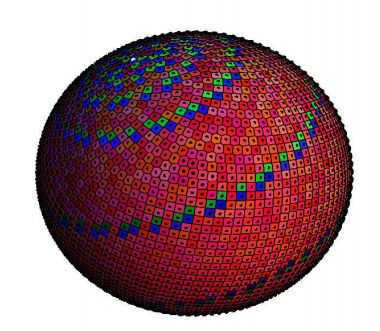
The blue color represents pentagons, the red color represents hexagons, and the green color represents heptagons in this model. The structure of phyllotaxis occurs in nature when sunflower seeds are arranged in a corolla and is achieved by overlaying the Fibonacci lattice on the sphere. This arrangement describes the optimal placement of neighboring modules, which is essential for assembling a Dyson sphere. To learn more about this fascinating geometric structure, I recommend visiting Hubre.
According to this source, there are calculations available regarding the strength and manufacturing process of the Dyson sphere.
"Assuming the sphere is made of steel and has a radius of 1 a.u. (although this value can vary since a larger sphere can tolerate a weaker material), the resulting pressure is 3.5 TPa. This pressure is nine times higher than the pressure at the center of the Earth and seven times higher than what can be achieved in a laboratory setting. These values far exceed the strength of steel, which can withstand pressures in the range of hundreds of megapascals, depending on the grade. However, this strength is tens of thousands of times lower than what is required to stabilize a Dyson sphere."
Summary
In conclusion, the design and construction feasibility of the Dyson sphere are heavily influenced by three factors:
1. The specific physical characteristics of the star and planetary system where the sphere is to be built. It is worth noting that some studies propose searching for Dyson spheres around white dwarfs.
2. The intended purpose of the Dyson sphere, whether it be to harness colossal solar power or to provide living space on the inner surface of the sphere. The purely energetic purpose appears to be more achievable.
3. The level of complexity and intelligence of individual modules on a Dyson sphere may vary. It is possible that a group of von Neumann probes could be utilized to construct the Dyson sphere using the particles within the same group, given that the robots are made of a suitable material such as carbon nanophene and have a verified lifespan. After a certain period of operation, these robots could be disassembled by other robots to obtain materials for construction or repairs on the sphere.
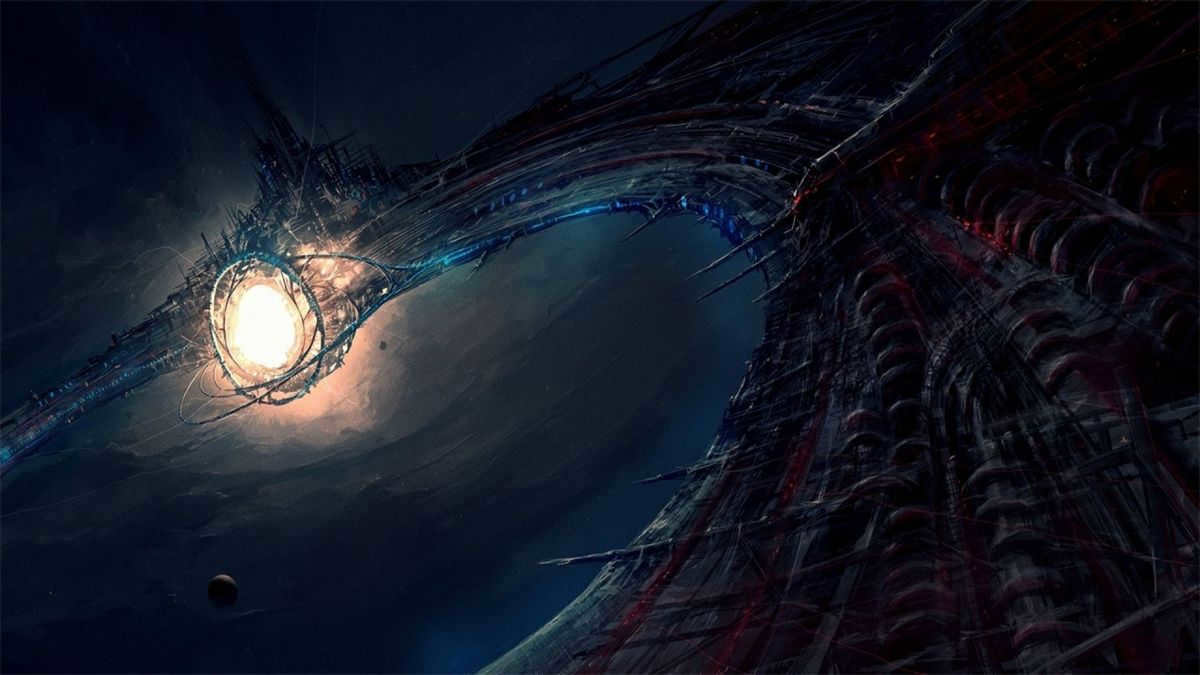
What possibilities for energy sources can civilizations at a significantly higher level of development than us possess? Let’s explore three fascinating concepts: the Dyson Sphere, stellar engine, and the “bomb from a black hole”.
The Dyson Sphere
First, let’s delve into the most well-known and ambitious concept of the three.
The concept involves utilizing the star itself as an energy source. Take our Sun, for example – a yellow dwarf that emits a staggering 3.828⋅10 26 W of energy. To put it into perspective, that’s equivalent to 4.74⋅10 18 warhead explosions, each with a yield of 250 Kt. Talk about overkill.
In 1937, The Star Maker, a science fiction novel by Olaf Stapledon, was released. This book served as the inspiration for theoretical physicist Freeman Dyson, who then popularized the concept of a megastructure – a massive sphere that surrounds a star at the same distance as a planet’s orbit. The purpose of this megastructure is to capture and utilize all of the energy radiated by the star, providing more than enough power for a highly advanced civilization with a population numbering in the trillions.
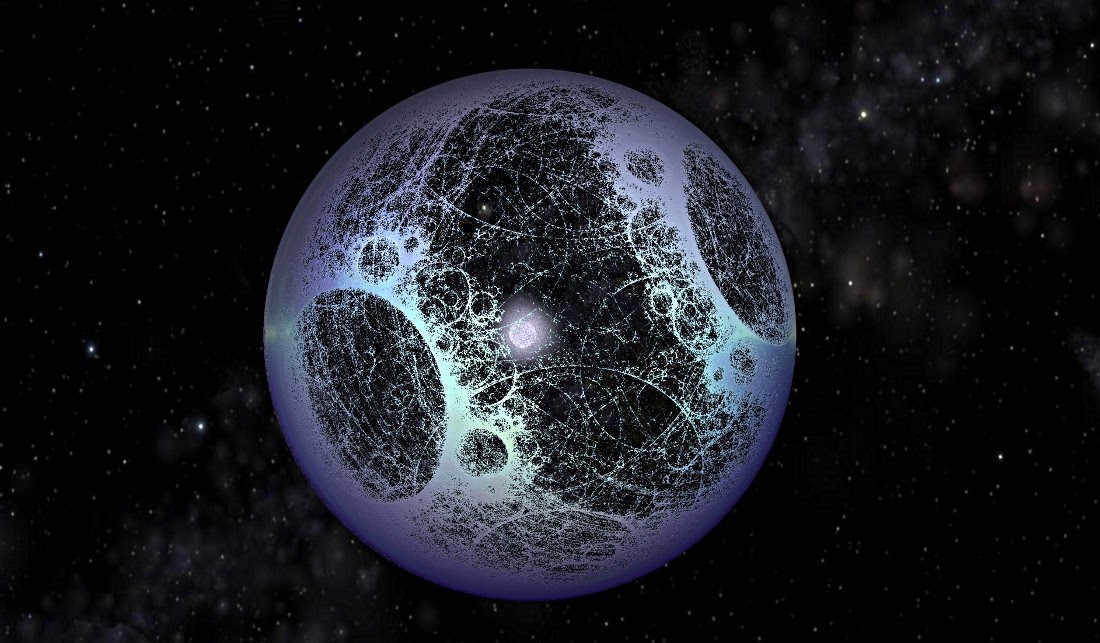
However, there have been and still are many critics of the concept of the Dyson sphere who present valid arguments against its technical feasibility and logical and social significance of such a megastructure.
First and foremost, the construction of such a structure would require utilizing an entire planet’s worth of building materials.
Secondly, building a sphere of this magnitude would necessitate the creation of massive production facilities and transportation methods, not to mention the energy sources needed for such a task.
Thirdly, any rigid structure, whether spherical or cubic, would inevitably be susceptible to destruction from numerous asteroids, comets, or centripetal acceleration – the Dyson sphere would need to rotate to counterbalance the gravitational force of the star.
Instead of a single rigid megastructure, we can utilize a massive swarm of inexpensive satellites, each equipped with mirrors that reflect sunlight onto receiver-collectors, which will then convert it into usable electricity. While the efficiency of this system may not match that of a monolithic structure, the engineering complexity of creating a swarm is significantly lower. For instance, we could potentially tap into the abundant minerals and metals found on Mercury, as its low gravity, thin atmosphere, and proximity to the Sun make it an ideal resource for our needs. The assembly of these mirror satellites could be conducted in space, launching them into orbit as they are completed and ready for deployment.
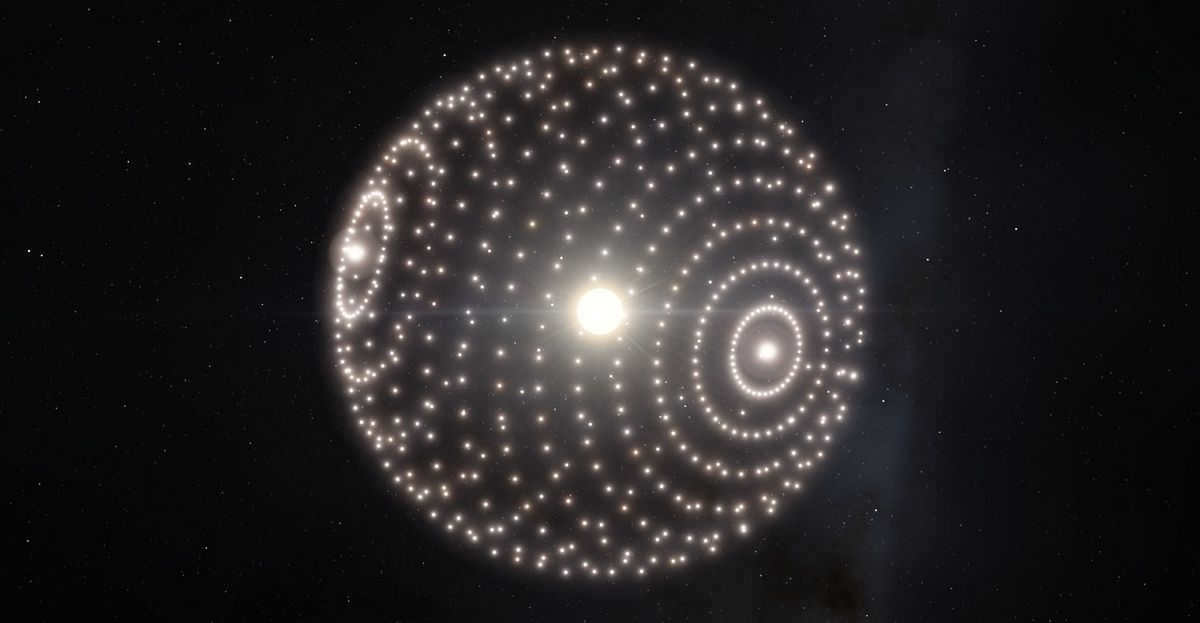
The quest for energy to fuel the massive volumes of mining and production requires a unique solution. The answer lies in harnessing the immense power of the Sun, and Mercury is abundant in this energy source. To maximize efficiency, the extraction, processing, and production processes should be automated. One possibility is to launch satellites into Mercury’s orbit to increase energy generation and boost productivity.
By utilizing a swarm of mirror satellites, it may be possible to capture even just 1% of the Sun’s radiated energy. This amount would be sufficient to eliminate the need for fossil fuels and open up opportunities for larger-scale projects, such as the development of interstellar transportation.
The explosive power of the black hole
Black holes are renowned for their ability to accumulate vast amounts of energy in the vast expanse of the Universe. However, harnessing this energy has proven to be an insurmountable challenge, as black holes act not only as accumulators but also as cosmic vacuum cleaners, devouring everything in their path. Nevertheless, scientists have proposed a radical idea – the creation of a mega structure that could potentially tap into the immense energy reserves of a black hole. However, this ambitious endeavor comes with a grave risk, as the mega structure could inadvertently transform the black hole into a catastrophic bomb of unimaginable power, capable of detonating with devastating consequences.
It is worth noting that not all black holes remain stationary; some possess the ability to spin rapidly around their axis, with frequencies reaching millions of revolutions per second. According to modern physics, at the core of every black hole lies a gravitational singularity – an infinitesimally small point with zero surface area, where the entire mass of the object is concentrated.
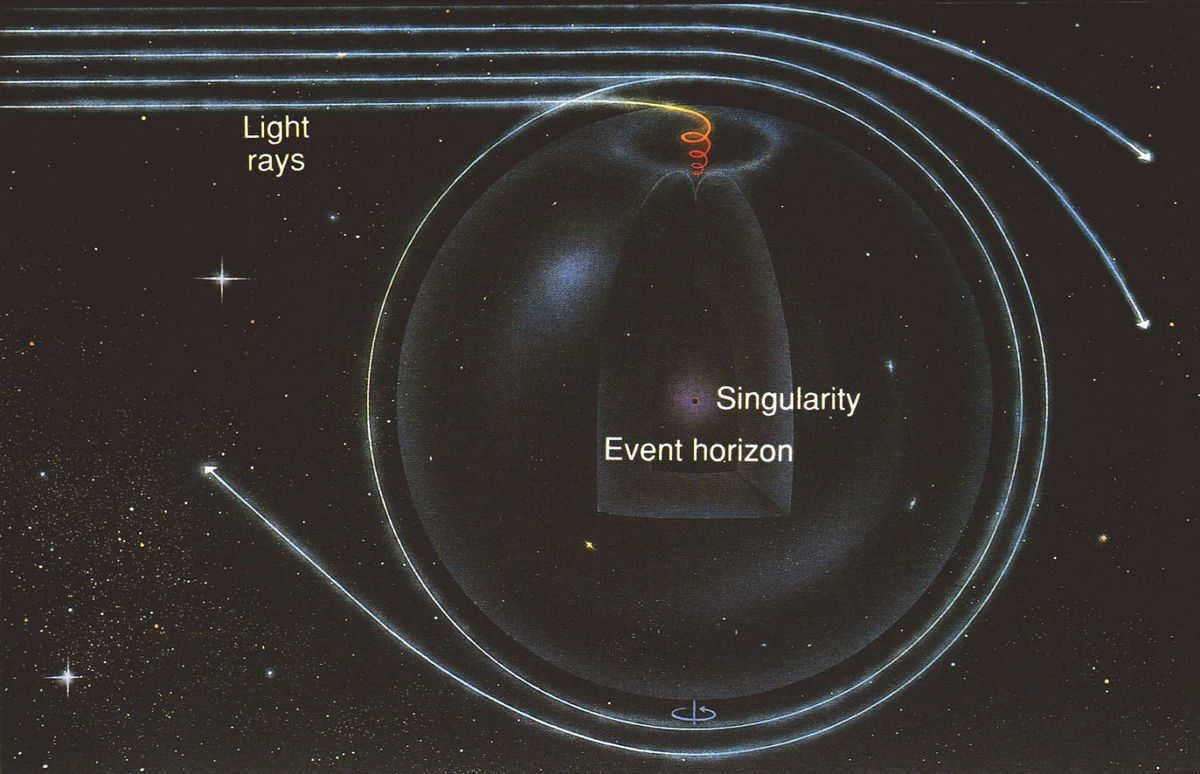
When it comes to a spinning black hole, the singularity also spins – instead of a point singularity, we refer to it as a ring-like singularity with no thickness and surface area.
The immense gravitational field of the black star causes the surrounding space-time to distort, and the rotation adds extra disturbances. This gives rise to the ergosphere, which is an elliptical region between the event horizon and the static limit of the black hole. Any object that falls into the ergosphere will inevitably start rotating along with the black hole. Moreover, within the ergosphere, there are already partial distortions of space-time present.
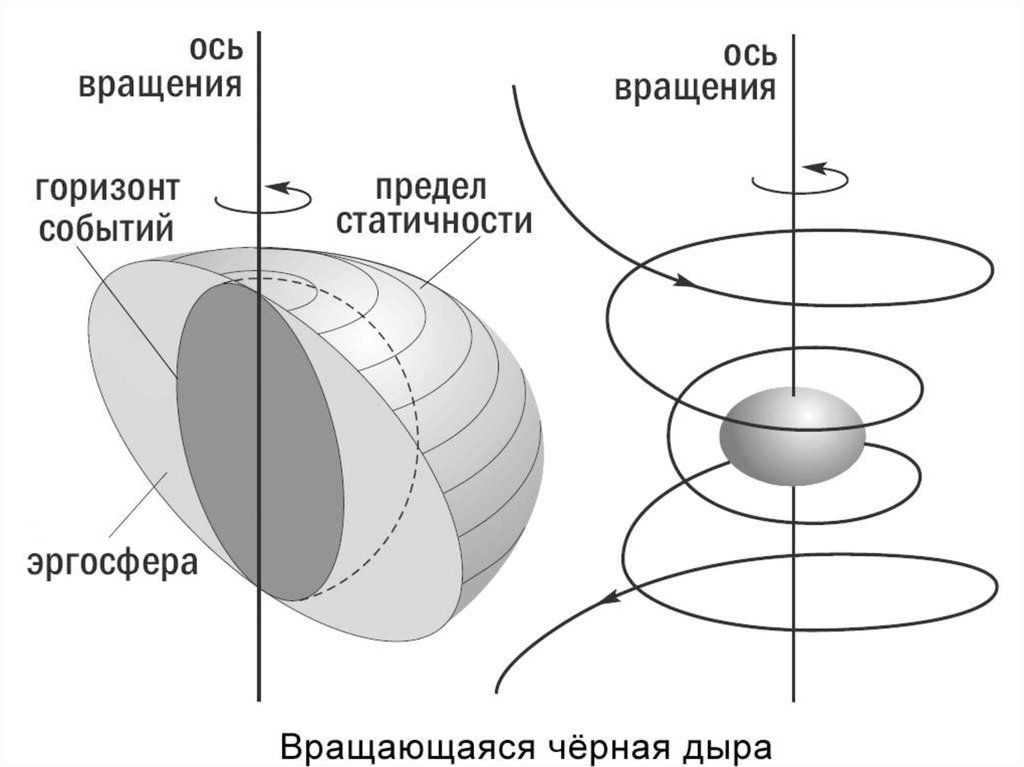
The black hole utilizes rotational motion to transfer its kinetic energy to all objects that enter the ergosphere. This concept forms the basis of the energy extraction idea, which can result in significantly larger energy volumes compared to those removed from a star by a swarm of satellite mirrors.
The dynamic processes within the ergosphere can be likened to a vortex forming around a drain hole. The rotation of the ergosphere also causes the magnetosphere surrounding the black hole to rotate. As a result, any object or particle that enters the ergosphere experiences a substantial acceleration. This acceleration can be so significant that it allows the object or particle to escape the ergosphere with much greater kinetic energy than it had upon entering. This phenomenon is similar to the slingshot effect.
Let’s imagine a scenario where an advanced civilization has discovered a rapidly spinning black hole and constructed a spherical shell of inward-facing mirrors around it. This shell is solid, similar to the well-known Dyson sphere concept. Fortunately, black holes are significantly smaller than stars, making the construction of the shell more feasible. Now, let’s create an opening in the shell and send a beam of electromagnetic waves into it. These waves are accelerated by the ergosphere and travel outward, reflecting off the mirrors, returning to the ergosphere, experiencing further acceleration, and repeating this process. However, it’s important to note that a portion of the waves will be lost as they fall into the event horizon. Each interaction between the radiation and the ergosphere exponentially amplifies the radiation. This phenomenon is known as the superradiation scattering effect, which was initially predicted by the Soviet physicist Yakov Zeldovich.
If we were to open a section of the shell surrounding a black hole, we would immediately unleash an incredibly powerful beam of energy. By inputting a small amount of energy, we would receive a much larger amount in return. For those who may be concerned about the law of conservation of energy and perpetual motion, we assure you that there is no magic involved here: the amplification of waves in the ergosphere causes the black hole’s rotation to slow down.
Theoretically, this megastructure could serve as an almost limitless source of energy for its creators.
If we were to fail to release energy from the shell in a timely manner, it would eventually explode. A supermassive black hole has the potential to expel an amount of energy equivalent to that of a supernova explosion.
A celestial motor
Stars are in constant motion, revolving around the nuclei of their galaxies and experiencing the gravitational influence of one another as they go. Despite being imperceptible to us, stars, along with their accompanying planets, hurtle through the vast expanse at incredible speeds, covering thousands of kilometers in a single second.
During their journey around the galactic center, star systems can encounter difficulties. For example, they may come dangerously close to an exploding supernova, traverse regions teeming with asteroids, or become ensnared in the gravitational pull of a massive star. Nevertheless, even if astronomers are able to foresee an unfavorable encounter that will take place in a million years, what actions can we take?
However, if our society evolves into a more advanced state – with the ability to construct a structure similar to the Dyson Sphere – future generations may have a different perspective. They may desire to alter the course of the solar system, guiding it towards a more favorable trajectory. In order to achieve this, they will construct a stellar engine that utilizes the energy emitted by the star to adjust its vector of movement.
The most basic choice is the Shkadov engine. It essentially consists of a parabolic solar sail constructed in close proximity to the Sun. The sail will deflect photons emitted by the star, generating a thrust that will alter the trajectory. To prevent the torch from scorching planets that pass through it, such as Earth, the reflector must be positioned outside the planes of their orbits. In the context of the Solar System, this implies that the Sun’s vector of motion will be oriented in such a way that the star will gradually depart from the Milky Way.
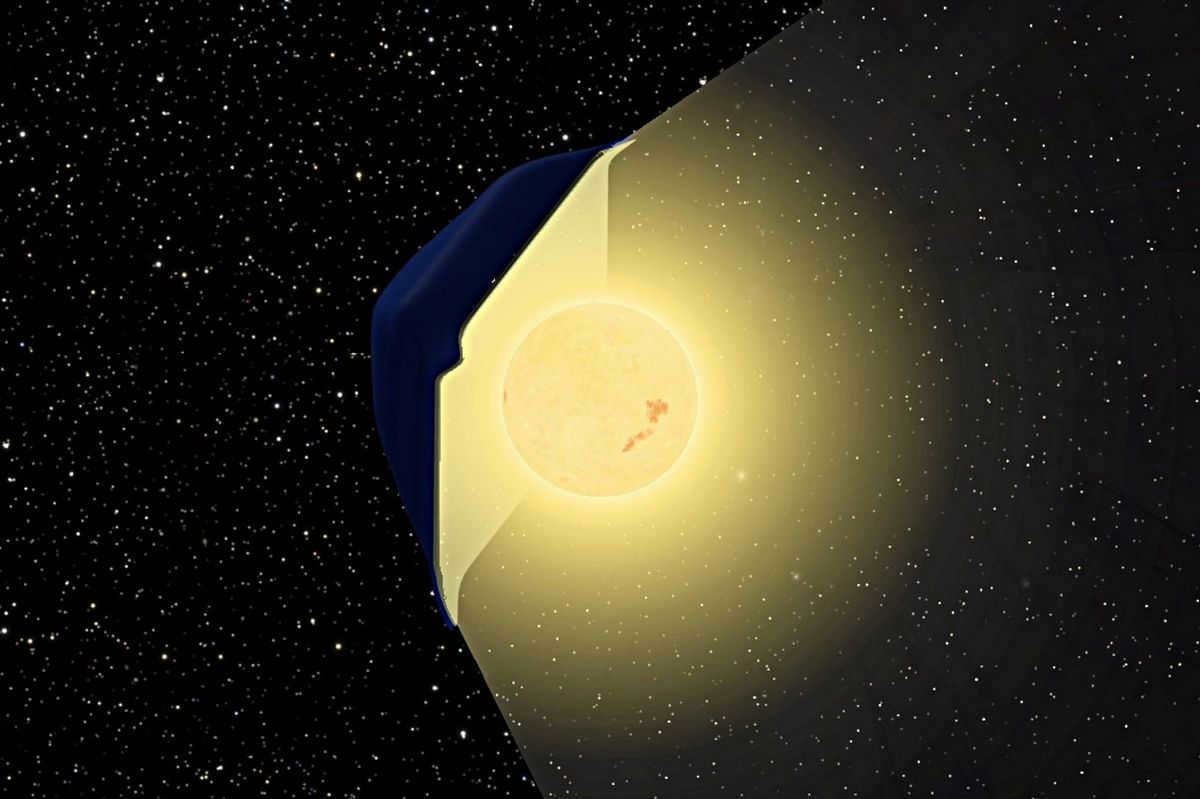
Theoretically, the gravitational attraction should be counterbalanced by the radiation pressure, implying that the reflector must have a minimal weight, specifically, it should be extremely thin – just a few microns thick. The parabolic shape is necessary to collect the reflected photons in a focused beam, otherwise the reactive thrust would not be sufficient to alter the star’s trajectory; indeed, the thrust of such an engine is already quite low. In practical terms, it can be likened to a homeopathic remedy.
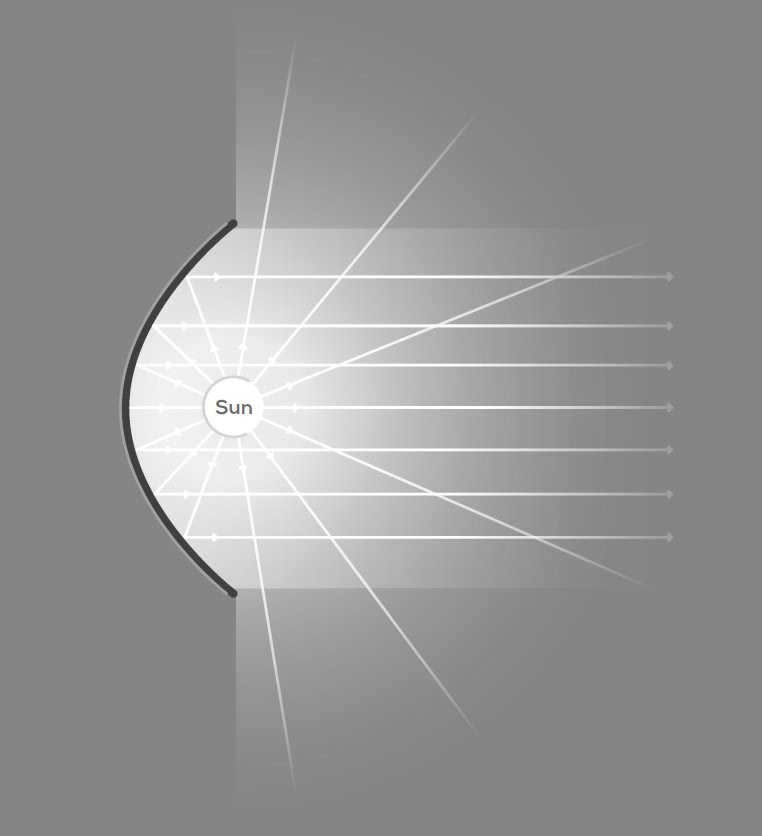
In the summer, Professor Matthew Kaplan came up with a unique concept for a stellar engine. The details of his proposal can be found in the peer-reviewed scientific journal Acta Astranautica: https://www.sciencedirect.com/science/article/abs/pii/S0094576519312457 (pdf).
Unlike Shkadov’s passive engine, Kaplan’s engine is an active fusion engine of immense proportions.
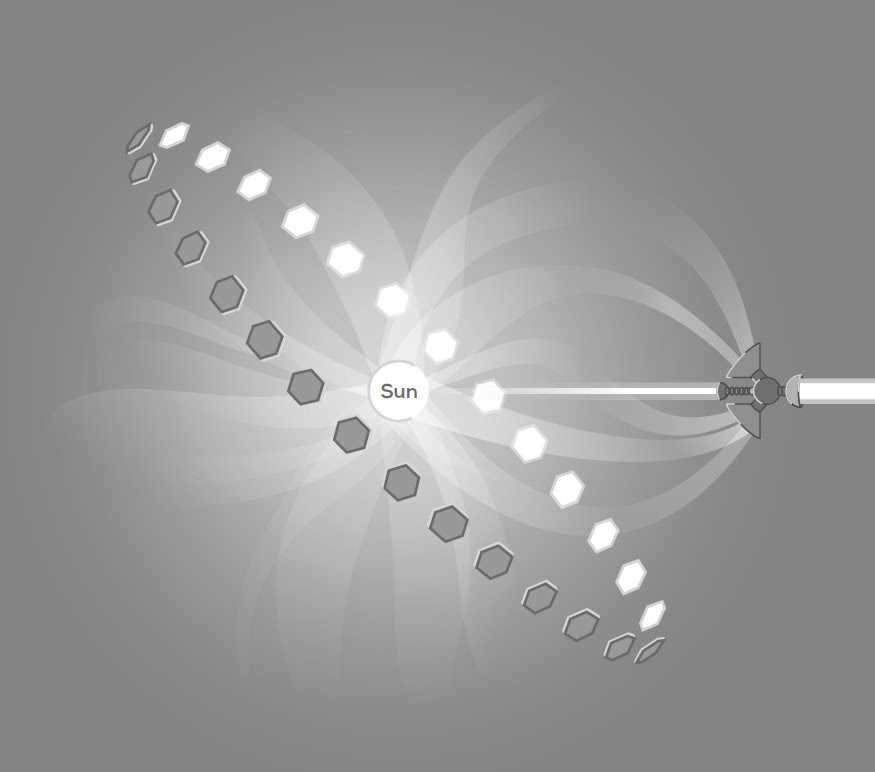
The lapse rate of the jet should be approximately 1% of the speed of light. Additionally, the second beam needs to be aimed in the opposite direction in order to exert force on the Sun itself. So, what is needed to power this “turbocharger”? According to the writer, the solution to this issue consists of two parts.
Firstly, the engine can utilize a strong electromagnetic field to draw in hydrogen and helium emitted by the Sun as “solar wind”. However, this amount of matter will not be sufficient to operate the engine. Therefore, by employing a swarm of mirror satellites as described above, it becomes feasible to concentrate the reflected sunlight onto a specific point on the surface of the star directly opposite the engine. This will result in localized overheating and the expulsion of billions of tons of material from the Sun. Rest assured, this will not harm the star, as it is already of substantial size.
The matter that is expelled can also be gathered and divided into helium and hydrogen in order to provide fuel for the immensely hungry thermonuclear stellar engine. A “counter-beam,” which serves to prevent the engine from colliding with the Sun, is a stream of hydrogen that is expelled at a high speed through the use of an electromagnetic gas pedal.
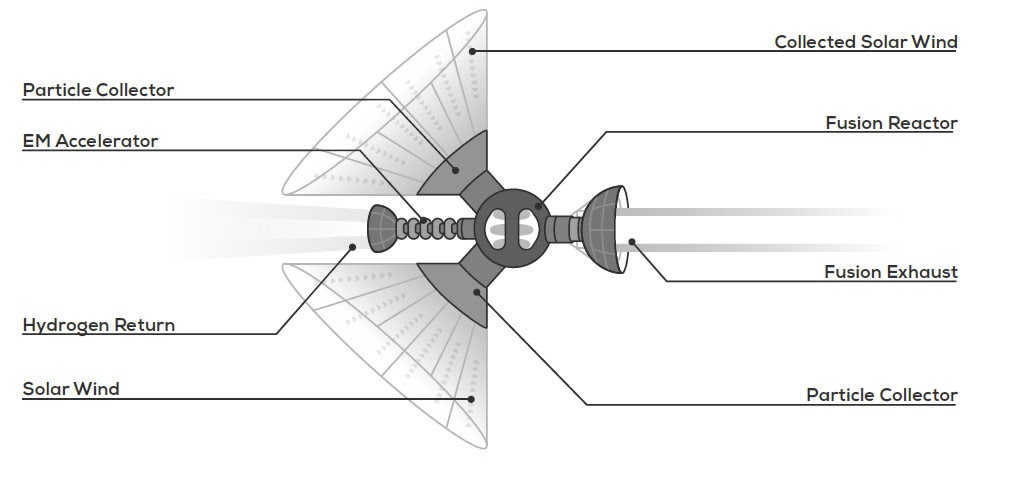
In comparison, Shkadov’s propulsion system has the capability to relocate the Sun a distance of 100 light years within a span of 320 million years, whereas Kaplan’s engine can achieve the same result in under 2 million years. This advancement would protect our habitat from the threat of supernovae. Additionally, it enables the possibility of interstellar travel, reducing the time required for space voyages and facilitating the colonization of other galaxies. Perhaps even relocating to Andromeda: within a mere 10 million years, the engine possesses the capacity to transport the entire solar system beyond the boundaries of our own galaxy.
As you can comprehend, megastructures like stellar engines are the domain of civilizations that have the ability to think in terms of vast time periods. Comparable to the two preceding structures.
The Dyson Sphere represents a colossal construct designed to harness the entirety of a star’s emitted light and convert it into usable energy.
In 1959, Freeman Dyson proposed the idea of a spherical stellar energy station. Little did he know that humans would one day be able to create such a structure, at least not in the near future. However, if a civilization were to harness the energy of a star, it would be classified as a Type II civilization and its power consumption would be on par with the central star of a planetary system, estimated to be around 4-1026 watts. [1]
Origin of the Concept
Freeman Dyson was influenced by the concept portrayed in the science fiction novel “The Star Maker” by Olaf Stapledon. Stapledon’s book, published in 1937, described a similar structure consisting of rings around stars devoid of planets and the creation of new artificial planets.
However, it is possible that Olaf Stapledon was inspired by another author, John Desmond Bernal. In Bernal’s article “The World, the Flesh, and the Devil,” he discussed the construction of spherical space colonies made of thin shells around asteroids that could be relocated to different orbits. Bernal also indirectly suggested that once these colonies became numerous, they would start to intercept a significant portion of our star’s energy.
There is no need for anything to be towed.
All construction is done on site. That means that materials are atomized and crystallized in space. The properties of these materials allow for repairs and upgrades when the original capacity is no longer sufficient. The sphere design is not practical, so we can look at other space forms that are similar. In the first stage, we start with just a ring. Eventually, we can have a cascade of rings. The key to planning a future Dyson Ring is choosing the right design for the standard element of the Ring. It should be standardized in size and shape for easy production and industry unification. However, it should also have enough flexibility in its design and architecture to allow for future upgrades and improvements that we can’t predict right now.
The design of the element should be straightforward and effortless to put together. The element’s surface should be concave in order to concentrate the light onto the energy receiver. The element’s center of mass should align with the geometric center for easy towing and orientation. [3]
Types [ ]
Cluster [ ]
The variation that closely resembles Dyson’s original concept is known as the “Dyson cluster”. It is comprised of numerous independent structures (typically solar-powered spacecraft) orbiting closely together around a star. This construction method offers several advantages: the components can be sized appropriately and it can be built gradually. [4] Various forms of wireless energy transfer can be employed to transmit power between the cluster components and the planet.
Arranging swarm orbits can be challenging due to the disadvantages caused by orbital mechanics. One simple solution is to create a Dyson ring, where all structures have the same orbit. However, more complex patterns with multiple rings can intercept a larger portion of the star’s output, but may also cause periodic overshadowing when their orbits overlap. [5] Another potential issue is the decreasing orbital stability as more elements are added, which increases the risk of orbital perturbations.
It is worth noting that a cloud of collectors will indeed change the emitted light from the stellar system. Nevertheless, the impact on the overall spectrum emitted by the star is expected to be minimal for astronomers on Earth. [6]
Dyson Bubble
An alternative form of the Dyson sphere is known as the “Dyson bubble”. Similar to a Dyson swarm, it is composed of multiple individual structures and can be constructed incrementally.
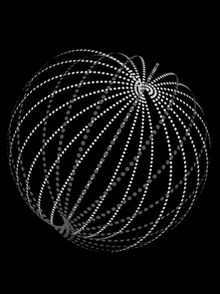
The Dyson swarm differs from its counterparts in that it does not revolve around the star. Instead, it consists of suspended satellite statutes that utilize enormous light sails. These sails harness radiation pressure to counteract the gravitational pull of the star. This unique design eliminates the risk of collisions or eclipses between the structures, as they remain stationary in relation to the star and are independent from one another. Additionally, the distance between the structures and the star can vary, as the ratio of radiation pressure to gravity remains constant regardless of proximity. This is assuming that each statute has unobstructed direct visibility of the star’s surface [7].
No working light sail has been created using such a material. The lightest carbon fiber light sail material in the world has a density of 3 g/m2 without payload, which is approximately four times the density required to create a solar statite. [15]
A single sheet of graphene, a two-dimensional form of carbon, has a density of only 0.37 mg per square meter, making it an effective solar sail material. However, large sheets of graphene haven’t been produced since 2015 and it has a relatively high rate of radiation absorption, around 2.3% (meaning about 97.7% will be transmitted). For frequencies in the upper GHz range and below THz, the absorption rate can reach 50-100% due to voltage bias and/or doping. [9]
Shell [ ]
A type of Dyson sphere that is frequently portrayed in works of fiction is the “Dyson shell.” This is a solid shell made of uniform matter that surrounds a star. [10] If constructed, this shell would significantly change the star’s emissions and capture all of its energy. Additionally, it would create a vast habitable surface that could potentially be used for living spaces.
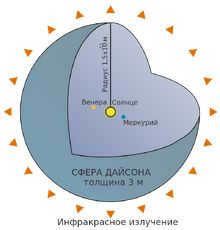
A Dyson sphere is a hypothetical megastructure that encompasses a star and captures its energy output. If such a sphere were built in our solar system, with a radius equal to the distance from the Sun to Earth, it would have a surface area of approximately 2.8 × 10 17 km 2 (1.1 × 10 17 sq. km 2), which is about 550 million times larger than Earth’s surface area. With this design, the sphere would be able to capture the full power output of the Sun, which is 384.6 W (3.846 × 10 26 W). Other designs that don’t involve a spherical shell would capture less energy. The shell option represents the maximum possible energy capture for our solar system’s current stage. It is estimated that this amount of energy is about 33 trillion times humanity’s energy use in 1998, which was 12 terawatts.
Criticism [ ]
The concept of constructing a Dyson Sphere has faced numerous criticisms, with one of the primary arguments being the practical infeasibility, especially when considering the long-term viability, of such a monumental undertaking. [13]
Sources [ ]
- ↑https://www.popmech.ru/technologies/370462-sfera-i-kolca-daysona-kak-nayti-v-kosmose-bratev-po-razumu/
- ↑https://habr.com/post/397719/
- ↑https://geektimes.com/post/280616/
- ↑http://www.aleph.se/Nada/dysonFAQ.html#BUILT
- ↑http://www.aleph.se/Trans/Tech/Megascale/dyson_page.html
- ↑http://www.islandone.org/LEOBiblio/SETI1.HTM
- ↑https://www.grc.nasa.gov/WWW/K-12/Numbers/Math/Mathematical_Thinking/sunlight_exerts_pressure.htm
- ↑http://www.aleph.se/Nada/dysonFAQ.html#ENOUGH
- ↑https://arxiv.org/abs/1201.3071
- ↑ 10,010,1http://www.aleph.se/Nada/dysonFAQ.html#WHAT
- ↑https://nssdc.gsfc.nasa.gov/planetary/factsheet/sunfact.html
- ↑http://www.inference.org.uk/sustainable/oomm.html
- ↑ Stanislaw Lem. The sum of technology. Notes (VI)
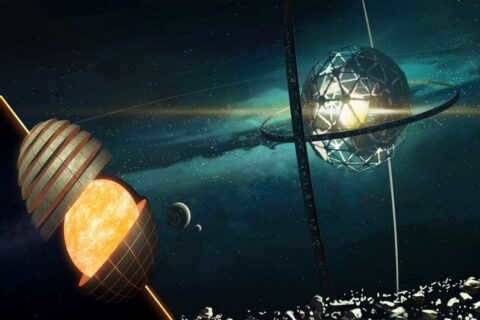
Today, we will be discussing another fascinating piece of science fiction technology! This time, our focus is on the Dyson sphere, a remarkable innovation that revolves around the manipulation of entire stars.
So, what precisely is a Dyson sphere? Is it merely a more affordable version of the Death Star? Let us delve deeper into the subject.
The idea originated as a hypothetical scenario, contemplating the means by which advanced civilizations could gather the necessary energy for interstellar voyages.
Typically, only a minute portion of a star’s energy reaches the celestial bodies orbiting it. However, what if it were possible to construct a colossal structure capable of harnessing the majority, if not all, of that energy? This is where the Dyson Sphere enters the picture.
In essence, a Dyson Sphere is an enormous construction that fully envelops a star, enabling it to derive its entire energy supply from the star itself.
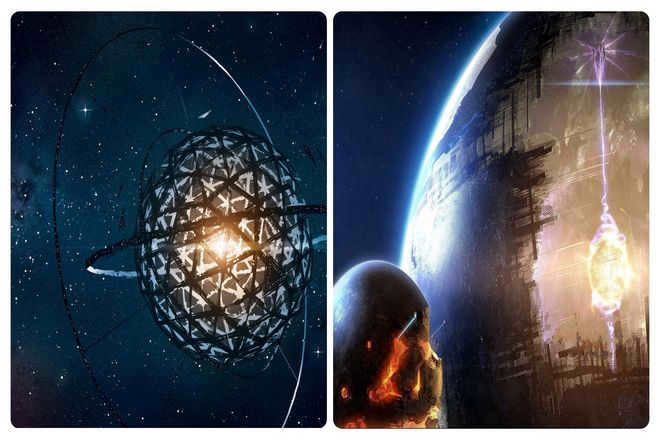
There exists a technique for assessing the level of advancement of a society based on its energy utilization, known as the Kardashev scale. This scale is categorized into three types, depending on the quantity of energy consumed.
Planetary civilizations, classified as Type I, have the capacity to consume 10^16 watts (W) and exhibit complete dominion over their home planet.
Type II civilizations, on the other hand, possess the capability to consume 10^26 watts and display control over their star.
Following Type II civilizations are stellar civilizations, some of which have the potential to evolve into galactic civilizations. These advanced societies consume approximately 10^36 watts (that’s 10 followed by 36 zeros). A Type III civilization would possess complete control over its entire galaxy.
From our perspective, a Type III civilization would essentially transcend into a divine state.
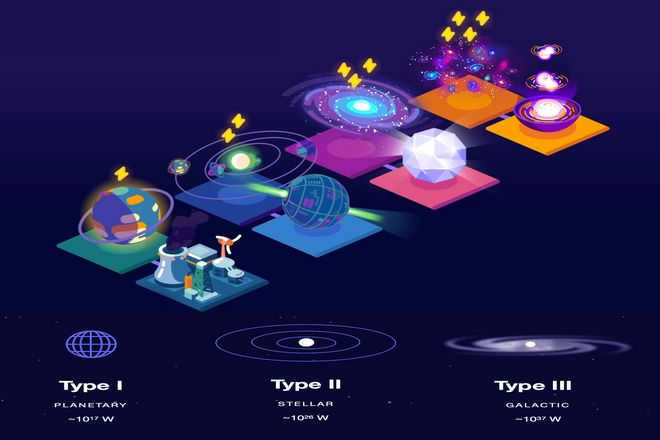

In terms of humanity, we have not yet reached the status of a Type I civilization. However, the development of nuclear technology is bringing us closer to that level.
A Type I civilization is characterized by its global reach, requiring cooperation and collaboration among all human beings. This is easier said than done.
In order to achieve Type I status, we must focus on the advancement of reliable nuclear fusion technology. Additionally, the ability to control weather patterns would also be beneficial!
Therefore, as long as we avoid the catastrophic consequences of nuclear warfare, it is possible for us to eventually become a Type I civilization.
Assuming that we were positioned on a Dyson Sphere, our current stage would be level II. It is important to note that the likelihood of us witnessing such a phenomenon is extremely remote, especially within the duration of our existence. However, it is not entirely implausible.
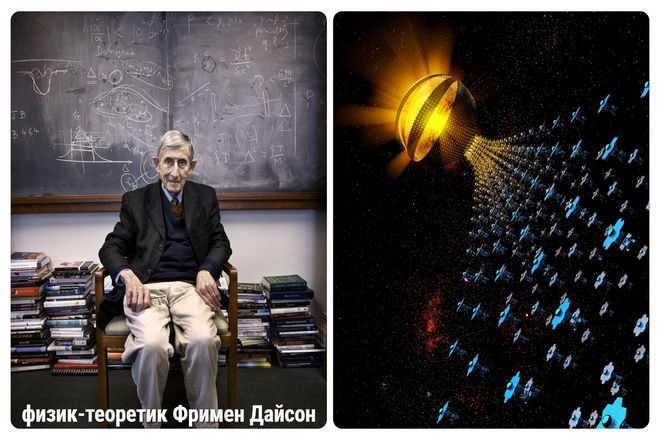
Designing the Dyson Sphere
At first, Freeman Dyson’s concept of the Sphere was essentially an empty shell. To illustrate, imagine a sphere and encase the Sun within it. We won’t delve into the plausibility of such a feat. However, it is safe to say that we would require a substantial amount of materials. To put it into perspective, we may need an entire planet’s worth of resources.
Centralizing all of it is undeniably simpler. In the event that any section of the Dyson Sphere were to malfunction, there is a significant risk of it collapsing and crashing onto the star, considering the rapid movement of objects in space. This could lead to potential damage or destruction of the sphere.
On the contrary, every satellite in the Swarm would be constructed with utmost efficiency. This is primarily due to the fact that the satellite nearest to the star is expected to experience the highest failure rate and is also the most challenging to repair.
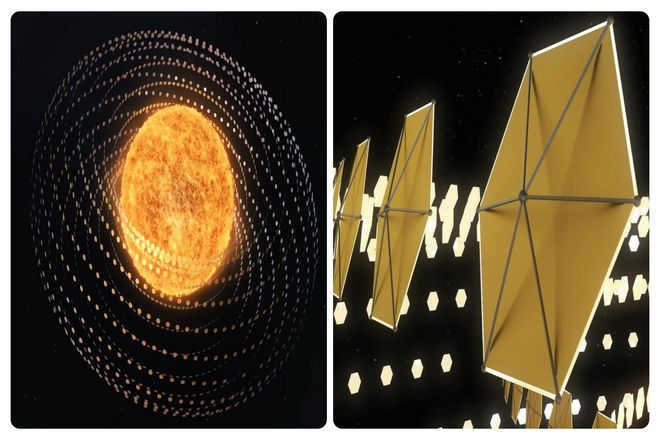

Therefore, it would be more convenient to replace the malfunctioning satellite by launching it towards the star. These satellites would likely consist of regular mirrors that redirect the energy from the star to a capacitor, which would be installed on the planet.
Is the Dyson sphere within our reach?
As of now, the search for a Dyson Sphere or any similar structure has yielded no results. However, there is one celestial object that has caught our attention – KIC 8462852, also known as Tabby’s Star. This star has become the subject of fascination due to its peculiar behavior.
What sets Tabby’s Star apart is the irregular changes in its brightness. It experiences significant dips in luminosity, up to 15% in some instances.
Furthermore, about two years later, there was a dip of 22% observed. Despite occasional dips occurring sporadically, no discernible pattern has been established.
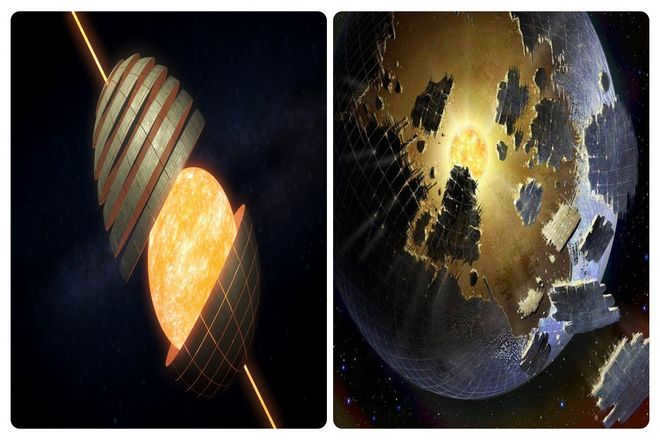

If a planet the size of Jupiter were to pass in front of a star, it would cause a decrease in brightness of approximately 1%. Therefore, whatever is causing the observed dips in brightness must be of significant size… perhaps even colossal.
Consequently, many experts have proposed the possibility of a Dyson structure existing around Tabby’s Star. Unfortunately, there are far more plausible explanations, such as the formation of planets or clusters of asteroids.
Nevertheless, the concept of an extraterrestrial megastructure is undeniably captivating. It also evokes a sense of awe and trepidation.
The Dyson Sphere is an extraordinary endeavor that involves the reconstruction of an entire star system, a concept that has captivated the imaginations of many. Periodically, the media releases articles about this awe-inspiring project, leaving readers in awe. Below are the key details surrounding this remarkable feat of engineering.

1. The Definition of a Dyson Sphere
The concept of a Dyson Sphere revolves around a theoretical construction that could potentially be created by an exceptionally advanced civilization around their own star. Typically, it is visualized as a sphere with a thin outer shell, boasting a diameter comparable to that of Earth’s orbit.
This innovative idea was initially proposed by Freeman Dyson, an esteemed American theoretical physicist, as a plausible explanation for the Fermi paradox. Dyson suggested that highly evolved extraterrestrial beings could reside within these spheres, choosing not to reveal themselves to the outside world.
Other variations of this concept also exist, such as ring systems encircling a star or intricate lattice structures.
2. The Purpose of Creating a Dyson Sphere
The creation of a Dyson sphere is driven by two primary objectives: expanding livable space and maximizing energy harnessing from stars. The Sun, being the primary source of energy on Earth, emits a significant amount of radiation that currently goes untapped.
A Dyson Sphere has the potential to capture nearly all of the Sun’s energy output, which is a staggering 3.827⋅10²⁶ J per second. This amount far exceeds the energy requirements of humanity by several orders of magnitude. Additionally, the inner surface area of a Dyson sphere, with a diameter of 1 astronomical unit (a.e.), is 550 million times larger than that of Earth. This ensures that no matter how the human population grows, there will always be ample living space for everyone.
3 Materials for Constructing a Dyson Sphere
The construction of a Dyson Sphere requires an immense amount of materials. Experts estimate that, in order to complete such a project, not only would we need to utilize all the resources available on Earth, but we would also have to dismantle other planets within our solar system, including Jupiter and Saturn. However, even with this extensive effort, the resulting material would only be sufficient for a sphere with a wall thickness of a few meters, rendering it quite fragile in proportion to its size.
Despite these challenges, the composition of the final material remains a mystery to most proponents of Dyson Sphere concepts. Rather than being comprised of metals and silicates, the majority of the material would consist of hydrogen, helium, and oxygen. Furthermore, the question of where humans would reside during the construction process remains unanswered.
4. What is a Dyson Swarm
When it comes to the Dyson sphere, its durability is a major concern. The problem lies not only in its thinness, but also in the internal stress, uneven heating, and various other factors that could cause it to disintegrate, even if it were a kilometer thick.
That’s why there has been a recent shift in presenting this colossal structure as a Dyson swarm, consisting of a multitude of space stations strategically positioned in coordinated orbits. This arrangement creates a highly dense, yet non-continuous sphere, addressing the challenges of durability.

5. Has a Dyson sphere been discovered anywhere?
Determining the existence of a Dyson sphere would pose a significant challenge if most advanced civilizations reside within them. The stars around which Dyson spheres are constructed would be virtually invisible in the visible light spectrum, and only an increased brightness in other parts of the spectrum could potentially “expose” them.
In 2015, scientists made a groundbreaking discovery when they observed that KIC 8462852, also known as “Tabby’s star”, experienced irregular and significant decreases in its brightness. This phenomenon led many to speculate that the star could be surrounded by a partially constructed Dyson sphere. However, further observations have failed to provide a clear explanation for these unusual fluctuations. Additionally, the absence of any signs of artificial signals from this star raises doubts about the existence of such a structure.
Stay updated with the most captivating news and facts by joining our Telegram channel!


